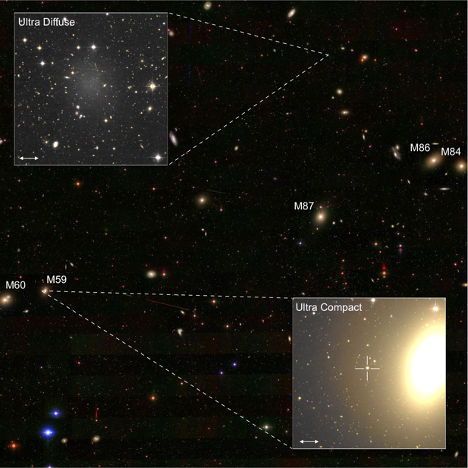Media
Transcript

Stay tuned after the Daily Space for a live interview with Dr. David Grinspoon of the Planetary Science Institute regarding yesterday’s news about phosphine in the atmosphere of Venus.
Growing up, I (like I assume many of you) had to memorize the steps in the scientific method. According to our classroom, science progresses by making hypotheses, designing careful experiments to test the hypotheses, and then analyzing the results and modifying the hypotheses as needed. I don’t know if science actually works that way in other fields, but that is seriously not how astronomy seems to work.
Starting with Aristotle, theorists have built the theories, often without actually looking at the universe, and declared that we should be able to understand our universe from first principles, assumptions, and careful confirmation. Observers, including the likes of Galileo and Tycho Brahe, have then looked at the universe, said something along the lines of, “So sorry, reality doesn’t match your theory,” and have demanded new theories, like Kepler’s equations of planetary motion. For a couple of thousand years, astronomy has advanced, one or more unexpected observations at a time.
One of the simple assumptions about our universe that turned out to be utterly and totally wrong was that we can see with our telescopes all the sources of gravity. In 1933, just four years Hubble discovered the universe is expanding, Fritz Zwicky discovered that galaxies in clusters don’t orbit as expected, and there must be some invisible pull – some dark, unseen, matter, that is out there exerting a pull on galaxies. Thirty years later, Vera Rubin found the same invisible matter is affecting the motions of stars in galaxy after galaxy. By the mid-70s, astronomers were starting to admit, yup, the universe is full up with invisible material of an unknown type that affects everything.
By the time I was in grad school at the turn of the century, theorists were working hard to model dark matter with smooth equations that describe how dark matter falls off with distance from a galaxy core or cluster core. It was initially assumed that visible matter consistently exists only in consistent dark matter halos, with the light and dark tracking one another, but then the COSMOS program mapped dark matter by looking at how it bends the light of background galaxies through an effect called microlensing, and it was discovered dark mass does at it pleases and exists on its own sometimes.
Since then, we’ve also found galaxies seemingly devoid of dark matter. Basically, dark matter is going to dark matter where it wants, but even with this new understanding, we continued to believe that dark matter doesn’t really clump up; that it is one or a family of particles that have very small collisional cross-sections that don’t really interact with the electromagnetic force and are generally making up some 30% of the universe. While it’s displeasing to not be able to blow something up and create a dark matter particle we can understand, at least, we thought, we had a handle on where it is and how it piles up.

But then observers (I love observers and was one for a long time) came along and used the Hubble Space Telescope to look closer at the distribution of dark matter in galaxy clusters than anyone has ever looked before, and they discovered dark matter absolutely does not have a nice smooth distribution.
In a new article in the journal Science, a research team led by Massimo Meneghetti has determined that there are dense clumps of dark matter associated with some galaxies in clusters. This was a two-step observation: the Very Large Telescope (VLT) was used to confirm galaxies belonged to the cluster and to measure the velocities of stars in those galaxies – a way to determine the galaxies’ masses using orbital mechanics. They also used the Hubble Space Telescope to look at how the light of distant objects was magnified and sometimes distorted and replicated by the overall gravitational pull of the cluster, and by the individual tugs of member galaxies.
To quote the press release: To the team’s surprise, in addition to the dramatic arcs and elongated features of distant galaxies produced by each cluster’s gravitational lensing, the Hubble images also revealed an unexpected number of smaller-scale arcs and distorted images nested near each cluster’s core, where the most massive galaxies reside. The researchers believe the nested lenses are produced by the gravity of dense concentrations of matter inside the individual cluster galaxies.
These dense concentrations are not part of our current models of the universe. According to Beneghetti: We have done a lot of testing of the data in this study, and we are sure that this mismatch indicates that some physical ingredient is missing either from the simulations or from our understanding of the nature of dark matter.
Co-author Priyamvada Natarajan goes on to add: There’s a feature of the real Universe that we are simply not capturing in our current theoretical models. This could signal a gap in our current understanding of the nature of dark matter and its properties, as these exquisite data have permitted us to probe the detailed distribution of dark matter on the smallest scales.
I have no doubt that we will quickly have multiple, overlapping theories to explain what’s going on. For now though, we have a delightful mystery. I, for one, look forward to seeing if these results can be replicated from studies of isolated galaxies. It would be really cool to know if these weird distributions only exist in clusters. Here is to hoping the team is already looking.
Galaxy clusters are a common target for telescopes. They are stunningly beautiful, they host a whole lot of objects in a very small region of the sky, and they, unlike star clusters, contain a myriad of different kinds of objects. As our telescopes get better and better, and as astronomers look for longer and longer periods of time, the diversity of what we see has grown.

In a new paper in The Astrophysical Journal (ApJ), Chengze Liu and collaborators have explored the population of ultra-compact dwarf (UCD) galaxies and ultra-diffuse galaxies (UDG) in the Virgo Cluster using MegaCam on the Canada-France-Hawaii Telescope (CFHT). This work was done as part of the Next Generation Virgo Cluster Survey.
These small, weird systems define the known edge cases in galaxy structure, and it is unclear if their structures are due purely to interactions within the cluster, or if they could initially form this way. The UCD galaxies look like either large star clusters in isolation or like the cores of galaxies that have been stripped of their halos. In some cases, wispy trains of stars surround them, leading to the thinking that they may, at least in some if not all cases, be regular galaxies that lost a lot of their content.
On the other extreme, the UDGs are simply confusing, as they appear to have globular clusters that usually require galaxy-condensing events to form. According to co-author Sungsoon Lim: The diversity in their properties indicates that while no single process has given rise to all objects within the UDG class, at least some UDGs have appearances suggesting their diffuse nature is due to tidal interactions or to the merger of low-mass galaxies.
Sometimes what amazes me most about science is that we can explain our universe and predict things fairly well at the largest scales while not knowing all the details. Science works, at least as long as you don’t look too closely at things.
And we’re working on getting science to work when you look at the details, too.
One of the places where people are working the hardest may be our study of Type 1a supernovae. These exploding stars are defined as growing white dwarfs that hit a critical mass and explode when they can no longer support themselves against the crush of gravity from their suddenly too-large mass. Since they should all explode at the same mass, and since the same mass exploding should release the same amount of energy, it’s been thought that type 1a supernovae should be really good standard candles we can look at and say, “Ok, that thing should be this specific luminosity, but since it appears only so bright, it must be this specific distance away.” The thing is, it turns out white dwarfs can get themselves into no end of weird situations.
In a new paper in ApJ and led by Eric Hsiao, a weird type 1a supernova has been seen growing in brightness ever so slowly, and the rise and fall in the brightness of certain spectral lines didn’t match what is generally expected. One theory, however, did correctly predict what they were seeing, showing theorists do sometimes get things totally right.

In this case, it appears that according to Hsiao: This is the first strong observational proof that a Type Ia supernova can explode in a post-AGB or proto-planetary-nebula system and is an important step in understanding the origins of Type Ia supernovae. These supernovae can be particularly troublesome because they can mix into the sample of normal supernovae used to study dark energy. This research gives us a better understanding of the possible origins of Type Ia supernovae and will help to improve future dark energy research.
From these visible, weird objects – from the oddly forming stars and the disastrously distorted galaxies – the invisible is traced out, allowing us to know that our universe is mostly dark matter and dark energy, and what remains to be seen in our telescopes… well, it is there to test our understanding.
The universe is weird, and it is awesome, and sometimes – sometimes – we understand what is going on.
Learn More
Holding Up a Mirror to a Dark Matter Discrepancy
- European Space Agency press release
- NASA Hubblesite press release
- Yale University news article
- “An Excess of Small-Scale Gravitational Lenses Observed in Galaxy Clusters,” Massimo Meneghetti et al., 2020 Sep. 10, Science
Galactic Census Reveals Origin of Most “Extreme” Galaxies
- CFHT press release
- “The Next Generation Virgo Cluster Survey (NGVS). XXX. Ultra-diffuse Galaxies and Their Globular Cluster Systems,” Sungsoon Lim et al., 2020 Aug. 13, Astrophysical Journal (preprint on arxiv.org)
- “The Next Generation Virgo Cluster Survey. XXXIV. Ultracompact Dwarf Galaxies in the Virgo Cluster,” Chengze Liu et al., 2020 Sep. 10, Astrophysical Journal Supplement Series (preprint on arxiv.org)
Research Team Discovers Unique Supernova Explosion
- Florida State University News article
- Carnegie Science press release
- “Carnegie Supernova Project II: The Slowest Rising Type Ia Supernova LSQ14fmg and Clues to the Origin of Super-Chandrasekhar/03fg-like Events,” E. Y. Hsiao et al., 2020 Sep. 10, Astrophysical Journal (preprint on arxiv.org)
Credits
Written by Pamela Gay
Hosted by Pamela Gay
Audio and Video Editing by Ally Pelphrey
Content Editing by Beth Johnson
Intro and Outro music by Kevin MacLeod, https://incompetech.com/music/


 We record most shows live, on Twitch. Follow us today to get alerts when we go live.
We record most shows live, on Twitch. Follow us today to get alerts when we go live.